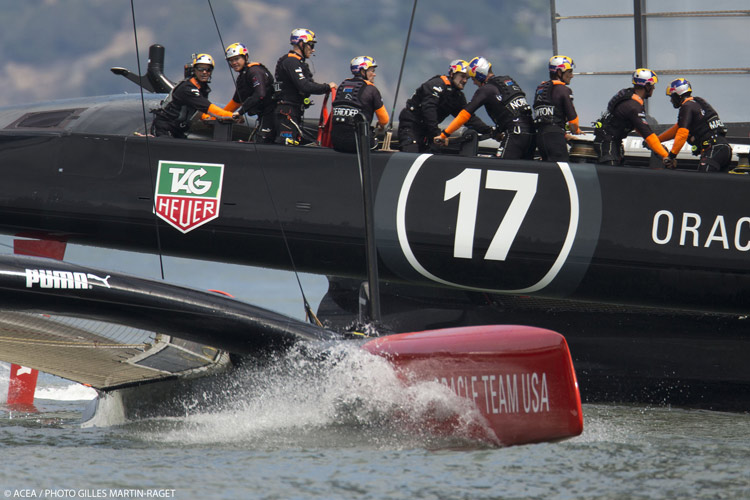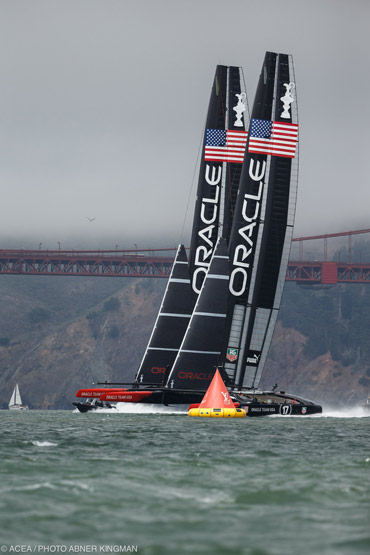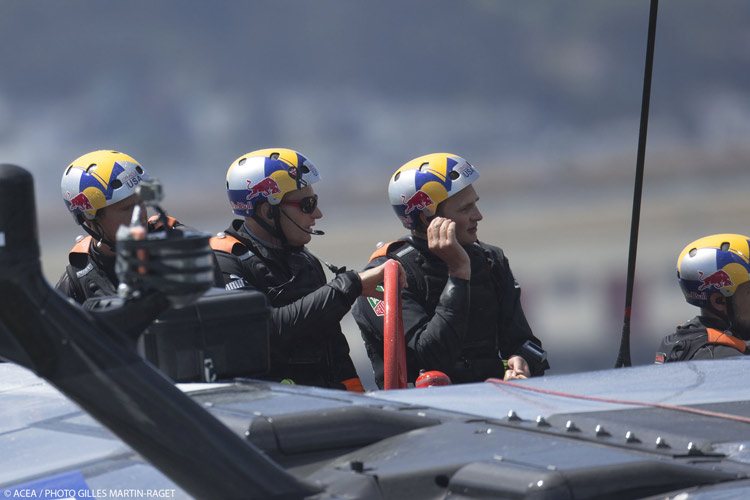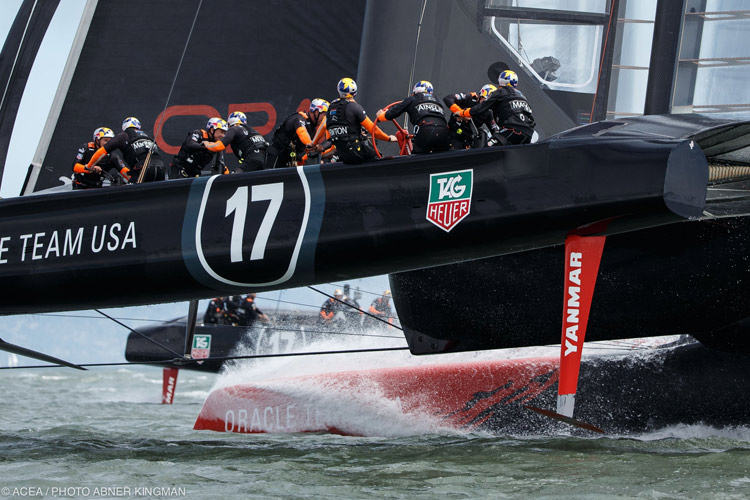Oracle Team USA Prepares by Pitting Spithill vs. Ainslie
Ben Ainslie: "You can’t sail these boats at less than 100%
downwind"
San Francisco, September 4, 2013

Image:©2013 ACEA/Gilles
Martin-Raget
 |
|
| Image:©2013 ACEA/Photo: Abner
Kingman |
Will the Defender be ready? That's been a question in every America’s Cup since the last true defender selection trials took place in 1995, when three separate American campaigns vied to become the Defender. Since then a single team has represented the yacht club holding the trophy, and instead used an in-house two-boat competition to prepare themselves for the America's Cup Match while the Challengers raced each other in the Louis Vuitton Cup.
For 2013, Oracle Team USA has America’s Cup winner James Spithill, now a Cup veteran, dueling against four-time Olympic gold medalist Ben Ainslie. Needless to say, the shore crews have been busy.
Spithill, in his fourth America’s Cup, knows that he and his team have to be ready for Emirates Team New Zealand on September 7. The team claims they are racing as hard as anyone did in the Louis Vuitton Cup, which saw several breakdowns, two crew overboard in a near-pitchpole, and some boat-to-boat contact in the pre-start, not to mention clocking of 50-mph top speeds. But are they really going to the limit in testing as hard as they would in a race?
“We are pushing as hard as we can,” Spithill says. “It’s hard not to be at full throttle on these boats, there really is no in-between. If you look at our racing versus the challengers' racing, it’s quite a lot different. We’re getting pushed, we’re getting under a lot of pressure – and that’s exactly what we need.”
Oracle Team USA took advantage of opportunities during the Louis Vuitton Cup final to duplicate race conditions as exactly as possible, not just racing on the actual course with the official boats present, but even, when possible, with the television broadcast environment up and running.
“It was great to test our program with the cameras and under the pressure,” Spithill says. “The whole tone was different in the team, we’ve learned a lot. That’s why we designed our campaign on a two-boat program, having two very competitive teams and two competitive boats.”
Two boats training at once was an option that all the teams were permitted, but in the combination of circumstances and finances only Oracle, believing it necessary to their chances of winning, managed to do so with their own boats. ETNZ did not sail both of their boats at the same time, concentrating resources on Boat #2 once it was ready. Luna Rossa only built one boat, though training with it at times against ETNZ, and Artemis Racing had the issue decided for them when their first boat was wrecked last May before their second boat was launched.
The challengers were relying on finding their competition in the challenger selection series, the Louis Vuitton Cup. Oracle was committed from the outset to the principle that in a challenge cup the defender should not interfere in the challenger selection process, potentially altering the outcome and diminishing expectations for the America's Cup Match itself. Sailing two boats with two crews was their only route to gaining race experience. Oracle hopes that the arrangement turns out to their advantage.
“We’re going to play our two-boat card as much as we can,” Spithill says. “That’s one of our trump cards – you’ve seen the challenger racing and you’ve seen our racing and I think it’s pretty obvious who has the better racing. So we’re going to keep pushing hard – that’s why we hired a lot of good sailors. We’ve got two great boats and we’re going to capitalize on that, push the race team as hard as we can. At this point in the game, I think everyone’s got their gear and it’s time to just get out there. It’s a pretty good problem that we’ve got right now, to have two very competitive boats.” Even in late August Spithill was hedging on which boat would sail in the match, saying they didn't know yet.
Ben Ainslie, new to both Oracle and America’s Cup multihulls since his last Olympic games win in Summer 2012, has been out there skippering Boat #1, sparring with Spithill and, he says, trying not to hold much back. A combination of structured testing and race setting is key to honing the boats and the crews.
“You can’t sail these boats at less than 100% downwind just because of the nature of the boat – they are really close to the edge,” Ainslie says. “One small mistake and you’re in a lot of trouble. It’s zero-tolerance sailing. But in testing, we can do more upwind, like change modes and the set-up a little bit.”
Having two competitive boats, with the apparent distinction being primarily that one is quicker, but more difficult to sail, and two competitive crews, may also be some insurance for Oracle Team USA in case of damage to either boat or sailor.
Though Ainslie has designs on taking the wheel of his own America’s Cup challenger in the future, members of the Oracle camp note that, as intended, Ainslie’s role here has been to push Spithill off the water as well as on.
And nobody admits Ainslie’s done that more readily than
Spithill. “Ben Ainslie is the best sailor in the world,” he says.
“So for me, it’s great to be pushed. You can only get better if you’re
training against someone who’s very good. What he’s done with that group
of guys, it’s a fantastic program. But also we’re pretty good mates, so
we’re able to develop the boats at the same time. Without him, there’s no
way we’d be able to progress as we are. And it means we have options – if
we have two sailing teams, we have the ability to have everyone backed up.
You never know what can come up during the Cup, sickness or injury – you saw
what happened to the Kiwis - so we’re prepared if something happens.
That’s the only thing we can do now; be as prepared as we can.

Image:©2013 ACEA/Gilles
Martin-Raget
The preparation is continuing all the way to Saturday’s starting gun. Ainslie says it has to.
“You’re learning all the time,” says Ainslie. “It’s a massive learning curve, maybe a little bit steeper for me than anyone else. As a sailor, it’s rewarding, almost like being back at sailing school, the first time you were sailing an Opti or something. You’re learning how to fly, learning the nuances of the boat, the race course. When the game changed to multihulls, suddenly we had to try to catch up with all the multihull experts. But we have a great team here and hopefully we can push Jimmy and the guys. They’re doing really well and I’m very confident in their abilities. I think we can keep pushing them, keep them honest, put them under a bit of pressure and that’s really what they need to be properly prepared for the race.”
They’ll be facing Emirates Team New Zealand and Skipper Dean Barker, who has played Ainslie’s role himself. Barker got his start leading the in-house “B-Boat” in aggressive style, tuning up Russell Coutts so thoroughly in the 2000 Defense of the America’s Cup, and ultimately sailing at Russell’s behest in the final race of the 5-0 “Blackwash” in Auckland.
Oracle Team USA got a brief opportunity to gauge their performance against Challenger ETNZ during the Louis Vuitton Cup Final, when the Kiwi boat dropped in on the Oracle race. Ainslie watched as Barker lined up against Spithill and while Ainslie joked about being a little bit annoyed with Dean and the boys for joining in, it was tantalizing moment even for the sailors themselves to have the chance to try and gauge their performance against their upcoming America’s Cup competitor. The question had to be asked: Who was faster?
“I think the speeds are pretty even,” says Ainslie. “I think our boats are a little bit higher, a little bit faster, but I think you’ll find the overall speeds are pretty even. If you asked me right now who I’d put my money on, I honestly couldn’t tell you.”
-- Diane Swintal for CupInfo/©2013 CupInfo.com

Image:©2013 ACEA/Photo: Abner Kingman
Additional Links and Info:
Daily Race Calendar for 2013 Louis Vuitton Cup and America's Cup